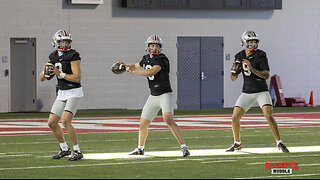Premium Only Content

Is cash still king?
Almost one-third of Americans buy into the idea that “cash doesn’t count,” according to new research.
A survey of 2,000 U.S. adults split evenly by gender and generation revealed that because their account balance doesn’t decrease, 29% of Americans believe that spending cash doesn’t actually “count” as spending money.
While this may be chalked up to just another “girl math” trend, 35% say that carrying cash makes them feel more prepared and only 5% admit that they never have some on their person.
Despite the stereotype that younger generations only prefer digital payments, the results revealed that baby boomers (24%) and Gen Xers (23%) are twice as likely to “rarely” carry cash than Gen Zers (12%).
The younger generations also prefer to carry a larger amount of cash than the older generations: Gen Z and millennials like to have an average of about $82 and $71 respectively, while Gen X carries $57 and baby boomers carry $48.
Interestingly, men tend to carry around $78, while women stick to an average of $51.
Still, all Americans are almost equally likely to carry cash out of paranoia or in fear that they might need it (27%) as they are to use it as “fun money” (26%).
Interestingly, 18% of Gen Z keep a cash fund because they frequent cash-only businesses, more than any other generation.
Conducted by Talker Research on behalf of Chime, the survey also looked to settle the debate over whether cash is considered to be the best of all payments or whether its reign has come to an end in the 21st Century.
Results found that cash might be making the comeback of the year as 52% agree that cash is king, compared to only 25% who believe it’s dead.
Taking that a step further, if Americans could eliminate one form of payment forever, both checks (36%) and credit cards (16%) ranked above cold, hard cash (12%).
Two-thirds of Americans even admit they’d rather find a $20 bill in their pocket than receive a $20 refund on their credit card (27%).
Almost three-quarters of Americans (73%) prefer to tip with cash over a card. They also prefer to use cash for groceries (22%), dining out (20%) gifts or allowances (18%) and for small businesses (17%).
Many respondents also seek out cash, by way of going to the closest ATM (43%) or going directly to their bank (43%).
But even so, many Americans worry that they will drop or lose the cash they carry (31%), that it will get stolen (26%) or have concerns that they’ll give into impulses and spend it too quickly (24%).
According to respondents, the worst situations to carry cash include in an unfamiliar city or state (32%), while traveling alone (31%) or on public transit (24%).
“Contrary to what many may believe, cash still plays a key role today,” said Janelle Sallenave, Chime’s Chief Spending Officer. “Compared to five years ago, 34% of all Americans are more likely to carry cash today. Interestingly, 40% of men are more likely, compared to only 29% of women.”
Overall, 64% of Americans have, at one time or another, experienced a “cash fart,” like a brain fart but for when you forget to bring cash with you.
Younger generations appear to be particularly susceptible, as only 14% of Gen Z and 18% of millennials say this has “never” happened to them, compared to 39% of baby boomers and 26% of Gen X.
But even so, almost two in five (39%) Americans admit they’ve experienced this within the last month.
Those Americans find themselves without cash an average of three times per month and are left with few options.
These experiences have resulted in being forced to use an ATM with a high fee (27%), being unable to purchase the goods or service they wanted (25%) or leaving them scrambling for a quick way to secure some dough (13%).
“Picture this: you’ve made it to the event you’ve been looking forward to for months. You’ve got your loved ones in tow and you’re ready for a great day. You pull up to the first vendor and see the dreaded ‘cash only’ sign, which makes you realize that you forgot to bring cash! What do you do?” said Sallenave. “No one enjoys a brain fart and a cash fart is no different.”
Survey methodology:
Talker Research surveyed 2,000 Americans split evenly by gender and generation (500 Gen Z, 500 millennials, 500 Gen X and 500 baby boomers); the survey was commissioned by Chime and administered and conducted online by Talker Research between August 29 and Sept. 5, 2024.
We are sourcing from a non-probability frame and the two main sources we use are:
● Traditional online access panels — where respondents opt-in to take part in online market research for an incentive
● Programmatic — where respondents are online and are given the option to take part in a survey to receive a virtual incentive usually related to the online activity they are engaging in
Those who did not fit the specified sample were terminated from the survey. As the survey is fielded, dynamic online sampling is used, adjusting targeting to achieve the quotas specified as part of the sampling plan.
Regardless of which sources a respondent came from, they were directed to an Online Survey, where the survey was conducted in English; a link to the questionnaire can be shared upon request. Respondents were awarded points for completing the survey. These points have a small cash-equivalent monetary value.
Cells are only reported on for analysis if they have a minimum of 80 respondents, and statistical significance is calculated at the 95% level. Data is not weighted, but quotas and other parameters are put in place to reach the desired sample.
Interviews are excluded from the final analysis if they failed quality-checking measures. This includes:
● Speeders: Respondents who complete the survey in a time that is quicker than one-third of the median length of interview are disqualified as speeders
● Open ends: All verbatim responses (full open-ended questions as well as other please specify options) are checked for inappropriate or irrelevant text
● Bots: Captcha is enabled on surveys, which allows the research team to identify and disqualify bots
● Duplicates: Survey software has “deduping” based on digital fingerprinting, which ensures nobody is allowed to take the survey more than once
It is worth noting that this survey was only available to individuals with internet access, and the results may not be generalizable to those without internet access.
-
 0:52
0:52
SWNS
18 days agoOver a third of Americans don’t drink water until after 3 p.m.
391 -
 1:50:51
1:50:51
Adam Carolla
5 days ago $12.92 earnedDave Portnoy RAILS against entitled, lazy Gen-Z Workforce + Comedian Dusty Slay | Adam Carolla Show
46.3K30 -
 12:10
12:10
Talk Nerdy Sports - The Ultimate Sports Betting Podcast
4 hours ago4/20/25 - Easter Sunday Special: Vas Resurrects the Slip & Buries the Books 🧾🔥
23.2K4 -
 15:00
15:00
Mrgunsngear
19 hours ago $5.98 earnedDan Wesson DWX: 2011 & CZ-75's Baby
43.7K21 -
 16:07
16:07
SKAP ATTACK
18 hours ago $5.32 earnedNuggets STEAL Game 1 Behind Jokic Mastery
61.3K11 -
 5:31:41
5:31:41
Big Fitz Plays
6 hours agoWho Gave Me a Chainsword?! | Space Marine 2 Chaos Stream
26.3K1 -
 22:16
22:16
marcushouse
20 hours ago $4.97 earnedFinally, the Starship Info We’ve Been Waiting For… And What We Can Do With It Is Wild!
51.1K20 -
 33:32
33:32
Ohio State Football and Recruiting at Buckeye Huddle
18 hours agoOhio State Football: What Position is the Biggest Question Mark for the Buckeyes?
41.4K2 -
 2:07:19
2:07:19
JahBlessGames
5 hours agoEASTER STREAM TEST
19.3K2 -
 9:30
9:30
VSOGunChannel
23 hours ago $2.05 earnedAdmin Actually Defending the 2nd Amendment?
29.9K12